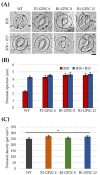Guard-Cell-Specific Expression of Phototropin2 C-Terminal Fragment Enhances Leaf Transpiration
- PMID: 35009069
- PMCID: PMC8747280
- DOI: 10.3390/plants11010065
Guard-Cell-Specific Expression of Phototropin2 C-Terminal Fragment Enhances Leaf Transpiration
Abstract
Phototropins (phot1 and phot2) are plant-specific blue light receptors that mediate chloroplast movement, stomatal opening, and phototropism. Phototropin is composed of the N-terminus LOV1 and LOV2 domains and the C-terminus Ser/Thr kinase domain. In previous studies, 35-P2CG transgenic plants expressing the phot2 C-terminal fragment-GFP fusion protein (P2CG) under the control of 35S promoter showed constitutive phot2 responses, including chloroplast avoidance response, stomatal opening, and reduced hypocotyl phototropism regardless of blue light, and some detrimental growth phenotypes. In this study, to exclude the detrimental growth phenotypes caused by the ectopic expression of P2C and to improve leaf transpiration, we used the PHOT2 promoter for the endogenous expression of GFP-fused P2C (GP2C) (P2-GP2C) and the BLUS1 promoter for the guard-cell-specific expression of GP2C (B1-GP2C), respectively. In P2-GP2C plants, GP2C expression induced constitutive phototropin responses and a relatively dwarf phenotype as in 35-P2CG plants. In contrast, B1-GP2C plants showed the guard-cell-specific P2C expression that induced constitutive stomatal opening with normal phototropism, chloroplast movement, and growth phenotype. Interestingly, leaf transpiration was significantly improved in B1-GP2C plants compared to that in P2-GP2C plants and WT. Taken together, this transgenic approach could be applied to improve leaf transpiration in indoor plants.
Keywords: Arabidopsis thaliana; BLUS1 (BLUE LIGHT SIGNALING1); phototropin2; stomatal opening; transpiration.
Conflict of interest statement
The authors declare no conflict of interests.
Figures






Similar articles
-
The C-terminal kinase fragment of Arabidopsis phototropin 2 triggers constitutive phototropin responses.Plant J. 2007 Sep;51(5):862-73. doi: 10.1111/j.1365-313X.2007.03187.x. Epub 2007 Jul 27. Plant J. 2007. PMID: 17662032
-
Arabidopsis phot1 and phot2 phosphorylate BLUS1 kinase with different efficiencies in stomatal opening.J Plant Res. 2016 Mar;129(2):167-74. doi: 10.1007/s10265-015-0780-1. Epub 2016 Jan 16. J Plant Res. 2016. PMID: 26780063
-
Both LOV1 and LOV2 domains of phototropin2 function as the photosensory domain for hypocotyl phototropic responses in Arabidopsis thaliana (Brassicaceae).Am J Bot. 2013 Jan;100(1):60-9. doi: 10.3732/ajb.1200308. Epub 2012 Nov 28. Am J Bot. 2013. PMID: 23196397
-
The action of enhancing weak light capture via phototropic growth and chloroplast movement in plants.Stress Biol. 2022 Dec 1;2(1):50. doi: 10.1007/s44154-022-00066-x. Stress Biol. 2022. PMID: 37676522 Free PMC article. Review.
-
The phototropin family as photoreceptors for blue light-induced chloroplast relocation.J Plant Res. 2003 Feb;116(1):77-82. doi: 10.1007/s10265-002-0072-4. Epub 2002 Dec 21. J Plant Res. 2003. PMID: 12605303 Review.
Cited by
-
Enhancement of the CRISPR/Cas9-Based Genome Editing System in Lettuce (Lactuca sativa L.) Using the Endogenous U6 Promoter.Plants (Basel). 2023 Feb 15;12(4):878. doi: 10.3390/plants12040878. Plants (Basel). 2023. PMID: 36840226 Free PMC article.
References
LinkOut - more resources
Full Text Sources

